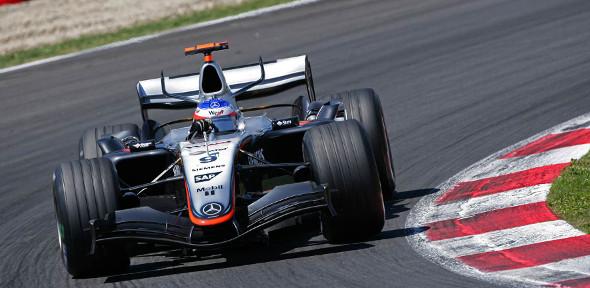
It has been reported recently in the motorsport press that Professor Malcolm Smith's "inerter" device and concept has been deployed in Formula One racing (e.g. Autosport, May 29, 2008, page 33, "Mark Hughes on... A genius idea, and why McLaren hasn't tried to stop others using it"). McLaren signed an agreement with the University for rights to exploit the technology in Formula One. After a rapid and confidential development process the inerter was raced for the first time by Kimi Raikkonen at the 2005 Spanish Grand Prix, who achieved a victory for McLaren. The inerter had been used for the first time in practice by McLaren at the previous race at Imola.
During development McLaren invented a decoy name for the inerter (the "J-damper") to keep the technology secret from its competitors for as long as possible. The inerter featured in the 2007 Formula One "spy scandal" when it was reported that the Renault engineering team failed to understand the purpose of the device from a McLaren J-damper drawing they had acquired - see the FIA World Motor Sport Council Decision, 7 December 2007. The fact that the J-damper is an inerter was revealed in the Autosport article. Cambridge Enterprise, the commercialisation office of the University of Cambridge, has now entered into a licence agreement with Penske Racing Shocks enabling Penske to supply inerters to any team in Formula One.
The inerter is a device which provides a force proportional to the relative acceleration between its attachment points ("terminals") which must be freely and independently movable in space. A typical realisation incorporates a flywheel which rotates in proportion to the relative displacement between the terminals. The first publication on the subject, in which the word "inerter" was coined, was: "Synthesis of Mechanical Networks: The Inerter" (M.C. Smith, IEEE Transactions on Automatic Control, Volume 47, Number 10, Pages 1648- 1662, October 2002). A patent on the device had previously been filed by the University.
The motivation for the inerter lies in the fields of electrical circuit synthesis and control systems. Classical circuit theory describes how to build circuits with the most general passive electrical impedances. Only three component types are needed: inductor, resistor and capacitor. There is an unexpected problem in translating this theory over to mechanical networks. Both the spring and damper have two terminals, but in contrast, the mass element has only one independently movable terminal. To achieve the greatest freedom to synthesize passive mechanical impedances a new element is needed which has two attachment points and where there is a proportionality between force and relative acceleration.
In a Formula One car the inerter can be used to improve "mechanical grip", i.e. to reduce tyre load fluctuations in dynamic situations. In conventional suspension design it is common to explain the role of individual components such as springs and dampers in achieving the overall goal. It is then natural to ask the question: what does the inerter do? Since the inerter is an energy storage element (like the spring) and not a dissipator (like the damper), an explanation in conventional terms is not immediately obvious. It is the fact that the inerter acts in combination with other elements (springs, dampers and masses) that the overall goal is achieved. To exploit the inerter the suspension designer is led to new methods which have their origin in electrical circuit synthesis.
It is pleasing that an idea which began with fundamental theoretical work in the Cambridge control group has led to this high profile exploitation in motor sport. Work is ongoing in the group to bring other applications of the inerter to fruition, e.g. in (1) vehicle suspensions for conventional road vehicles, (2) the control of motorcycle steering oscillations.

